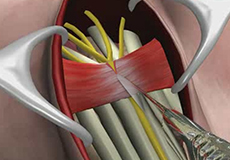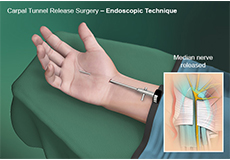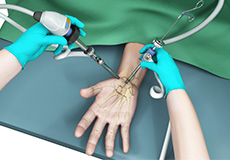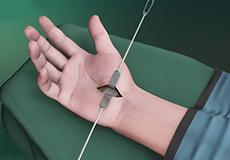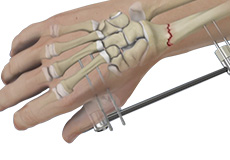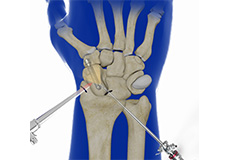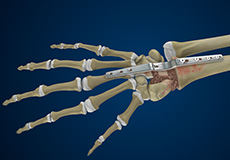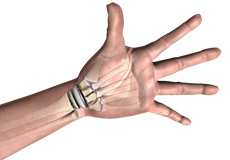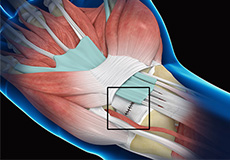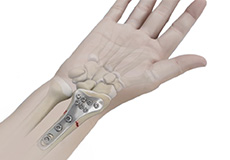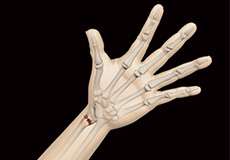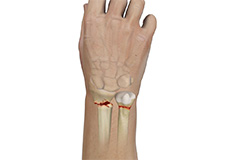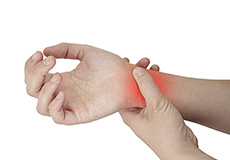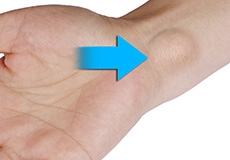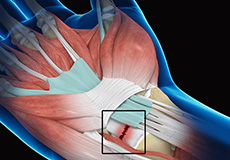-
Carpal Tunnel Release Surgery
Carpal tunnel syndrome can be treated with carpal tunnel release surgery. Traditional surgery involves an incision of up to 2 inches in the palm and wrist area, whereas endoscopic surgery involves one or two half-an-inch incisions and the use of an endoscope.
-
Endoscopic Carpal Tunnel Surgery
Endoscopic carpal tunnel surgery is performed after administering local anesthetic into the wrist and palm of your hand. You will be awake and may feel pressure, but will not feel any pain during the procedure.
-
Wrist Arthroscopy
Wrist arthroscopy is a minimally invasive surgical procedure performed to view, diagnose and treat problems of your wrist joint.
-
Hand Fracture Surgery
Hand surgery is performed to restore the structure and functionality of the fingers, wrist and hand secondary to a traumatic injury, medical condition, severe infection, or birth defect causing pain and/or deformity of the hand.
-
Wrist Fracture Fixation
Wrist fractures are breaks in any of the bones that form your wrist joint. Your wrist is made up of 8 small bones present in your hand and the adjacent ends of the 2 long bones of the forearm. The most common sites of fracture in the wrist are at the radius (the large forearm bone) and the scaphoid (one of the small hand bones).
-
Arthroscopic Partial Wrist Fusion
Arthroscopic partial wrist fusion is a minimally-invasive surgery that uses tiny incisions to immobilize selected bones of the wrist. The wrist joint is one of the most complex joints in the human body. It is made up of carpal bones and the two bones of the forearm: the radius and ulna.
-
Total Wrist Arthrodesis
Arthrodesis is the surgical immobilization of a joint by the fusion of the adjacent bones. Total wrist arthrodesis, also known as wrist fusion, is a surgical procedure in which the wrist joint is stabilized or immobilized by fusing the forearm bone (radius) with the small bones of the wrist.
-
Wrist Joint Replacement
Wrist joint replacement surgery, also referred to as total wrist arthroplasty, involves the replacement of a severe arthritic wrist joint with an artificial joint made of metal and plastic components. It relieves pain and restores function when conservative treatment fails to provide relief.
-
Wrist Ligament Reconstruction
Ligament reconstruction procedure can be performed as day surgery under local or general anesthesia. During the procedure, your surgeon first makes an incision over your wrist joint to locate the torn ligament. Once located, a tendon graft (tissue obtained from a donor part, usually the palmaris longus tendon of the same wrist) is used to replace the torn ligament.
-
Wrist Open Reduction and Internal Fixation
Open reduction and internal fixation of the wrist is a surgical technique employed for the treatment of severe wrist fractures to restore normal anatomy and improve range of motion and function.
-
Carpal Tunnel Syndrome
Carpal tunnel syndrome is a common, painful, progressive condition that is caused by compression of the median nerve at the wrist area.
-
Distal Radius Fracture
The forearm consists of two bones, the radius and ulna. The radius is the larger of the two forearm bones, and the region towards the wrist is called the distal end. A fracture or break in the distal end of the radius bone is known as a distal radius fracture.
-
Wrist Fracture
The wrist is comprised of two bones in the forearm, the radius and ulna, and eight tiny carpal bones in the palm. The bones meet to form multiple large and small joints. A wrist fracture refers to a break in one or more of these bones.
-
Wrist Sprain
Injuries caused due to stretching or tearing of the ligaments in the wrist are called wrist sprains. Sprains can range from mild to severe, based on the extent of injury to the ligament.
-
Wrist Injuries
The wrist is a commonly injured joint in the body. Problems include sprains and strains as well as fractures that can occur with lifting and carrying heavy objects, while operating machinery, bracing against a fall, or from sports-related injuries.
-
Wrist Tumors
A tumor is a lump or abnormal growth formed due to unregulated cell division. Wrist tumors can occur on or underneath the skin. They are most often benign (non-cancerous).
-
Wrist Ligament Tear and Instability
A ligament is a strong, flexible band of fibrous tissue. The wrist has many ligaments that help to keep the wrist bones in proper position providing stability to the joint. A torn ligament causes the wrist bones to move out of their position, which in turn leads to wrist instability as the sprained (torn) ligament can no longer support the wrist bones.
-
Wrist Pain
Wrist pain is defined as any ache or discomfort in the wrist. The wrist is comprised of two bones in the forearm, the radius and ulna, and eight tiny carpal bones in the palm. The bones meet to form multiple large and small joints. A trauma or injury to one or more of these bones results in wrist pain.
Hand Anatomy
The human hand is made up of the wrist, palm, and fingers and consists of 27 bones, 27 joints, 34 muscles, over 100 ligaments and tendons, and many blood vessels and nerves.
The hands enable us to perform many of our daily activities such as driving, writing and cooking. It is important to understand the normal anatomy of the hand to learn more about diseases and conditions that can affect our hands.
Bones of the Hand
The wrist is comprised of 8 carpal bones. These wrist bones are attached to the radius and ulna of the forearm to form the wrist joint. They connect to 5 metacarpal bones that form the palm of the hand. Each metacarpal bone connects to one finger at a joint called the metacarpophalangeal joint (MCP joint). This joint is commonly referred to as the knuckle joint.
The bones in our fingers and thumb are called phalanges. Each finger has 3 phalanges separated by two interphalangeal joints, except for the thumb, which has only 2 phalanges and one interphalangeal joint.
The first joint close to the knuckle joint is called the proximal interphalangeal joint (PIP joint). The joint closest to the end of the finger is called the distal interphalangeal joint (DIP joint).
The MCP and PIP joint act like hinges when the fingers bend and straighten.
Soft Tissues of the Hand
Our hand bones are held in place and supported by various soft tissues. These include: articular cartilage, ligaments, muscles and tendons.
Articular cartilages are smooth material that act as shock absorbers and cushion the ends of bones at each of the 27 joints, allowing smooth movement of the hand.
Muscles and ligaments function to control the movement of the hand.
Ligaments are tough rope-like tissues that connect bones to other bones, holding them in place and providing stability to the joints. Each finger joint has two collateral ligaments on either side, which prevents the abnormal sideways bending of the joints. The volar plate is the strongest ligament in the hand. It joins the proximal and middle phalanx on the palm side of the joint and prevents backward bending of the PIP joint (hyperextension).
Muscles of the Hand
Muscles are fibrous tissues that help produce movement. They work by contracting.
There are two types of muscles in the hand:
- Intrinsic muscles are small muscles that originate in the wrist and hand. They are responsible for fine motor movements of the fingers during activities such as writing or playing the piano.
- Extrinsic muscles that originate in the forearm or elbow control the movement of the wrist and hand. These muscles are responsible for gross hand movements. They position the wrist and hand while the fingers perform fine motor movements.
Each finger has six muscles controlling its movement: three extrinsic and three intrinsic muscles. The index and little finger each have an extra extrinsic extensor.
Tendons of the Hand
Tendons are soft tissues that connect muscles to bones. When muscles contract, tendons pull the bones, causing the finger to move. The extrinsic muscles are attached to finger bones through long tendons that extend from the forearm through the wrist. Tendons located on the palm side help in bending the fingers and are called flexor tendons, while tendons on top of the hand called extensor tendons help in straightening the fingers.
Nerves of the Hand
Nerves of the hand carry electrical signals from the brain to the muscles in the forearm and hand, enabling movement. They also carry the senses of touch, pain and temperature back from the hands to the brain.
The three main nerves of the hand and wrist include:
- Ulnar nerve: The ulnar nerve crosses the wrist through an area called Guyon’s canal and branches to provide sensation to the little finger and half of the ring finger.
- Median nerve: The median nerve crosses the wrist through a tunnel called the carpal tunnel. The median nerve provides sensation to the palm, thumb, index finger, middle finger and part of the ring finger.
- Radial nerve: The radial nerve runs down the thumb side of the forearm and provides sensation to the back of the hand from the thumb to the middle finger.
All three nerves originate at the shoulder and travel down the arm to the hand. Each of these nerves has sensory and motor components.
Blood Vessels of the Hand
Blood vessels travel beside the nerves to supply blood to the hand. The main arteries are the ulnar and radial arteries, which supply blood to the front of the hand, fingers, and thumb. The ulnar artery travels next to the ulnar nerve through the Guyon’s canal in the wrist. The radial artery is the largest artery of the hand, traveling across the front of the wrist, near the thumb. Pulse is measured at the radial artery.
Other blood vessels travel across the back of the wrist to supply blood to the back of the hand, fingers and thumb.
Bursae of the Hand
Bursae are small fluid-filled sacs that decrease friction between tendons and bone or skin. They contain special cells called synovial cells that secrete a lubricating fluid.


